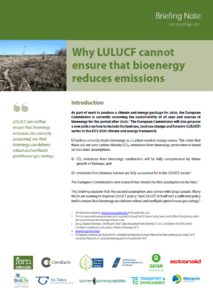 As part of work to produce a climate and energy package for 2030, the European Commission is currently reviewing the sustainability of all uses and sources of bioenergy for the period after 2020.1 The European Commission will also propose a new policy on how to include the land use, land use change and forestry (LULUCF) sector in the EU’s 2030 climate and energy framework. EU policy currently treats bioenergy as a carbon-neutral energy source. This claim that there are net zero carbon dioxide (CO₂) emissions from bioenergy production is based on two main assumptions: (i) CO₂ emissions from bioenergy combustion will be fully compensated by future growth of biomass; and (ii) emissions from biomass harvest are fully accounted for in the LULUCF sector. The European Commission’s own research has shown the first assumption to be false. This briefing explains that the second assumption also comes with large caveats. Many NGOs are seeking to improve LULUCF policy, but LULUCF in itself isn’t a sufficient policy tool to ensure that bioenergy use delivers robust and verifiable greenhouse gas savings.
As part of work to produce a climate and energy package for 2030, the European Commission is currently reviewing the sustainability of all uses and sources of bioenergy for the period after 2020.1 The European Commission will also propose a new policy on how to include the land use, land use change and forestry (LULUCF) sector in the EU’s 2030 climate and energy framework. EU policy currently treats bioenergy as a carbon-neutral energy source. This claim that there are net zero carbon dioxide (CO₂) emissions from bioenergy production is based on two main assumptions: (i) CO₂ emissions from bioenergy combustion will be fully compensated by future growth of biomass; and (ii) emissions from biomass harvest are fully accounted for in the LULUCF sector. The European Commission’s own research has shown the first assumption to be false. This briefing explains that the second assumption also comes with large caveats. Many NGOs are seeking to improve LULUCF policy, but LULUCF in itself isn’t a sufficient policy tool to ensure that bioenergy use delivers robust and verifiable greenhouse gas savings.
Key recommendations
A robust LULUCF policy and improved accounting rules for the sector are urgently needed. However, this will not automatically ensure that bioenergy production reduces greenhouse gas emissions, and additional rules in a sustainable bioenergy policy are strongly needed for that purpose. Below we provide some recommendations on both policies, from the perspective of ensuring real emission savings from bioenergy. A post 2020 bioenergy sustainability policy should include:
• The introduction of an EU wide cap on the amount of bioenergy that can be counted towards the EU 2030 renewable energy and climate targets. This would
limit the overall amount of biomass extracted from ecosystems for energy purposes. It would also ensure biomass extraction does not exceed sustainable supply, lead to a decline in carbon sinks or further deplete EU carbon stocks.
• The exclusion of high risk biomass sources such as crops from agricultural land (particularly from those planted on peatlands), roundwood, stumps and feedstocks that could be used to replace other carbon intensive materials. This will exclude sources of biomass that are most likely to produce net emissions through reduction in carbon stocks or through indirect land use change and sources that have other, more sustainable uses.
• A minimum threshold for the efficiency of energy production systems. This will direct limited biomass resources towards the most efficient energy applications.
A post 2020 LULUCF policy should:
• Measure forest management emissions transparently, simply and efficiently. Emissions from forest management are real, and should be mandatorily included
in accounting systems. All LULUCF sectors should be accounted for ‘net-net’, rather than according to a future reference level
• Set a separate target on LULUCF to incentivise increased carbon removals in the forestry and land sector without watering down emission reduction targets in other sectors.




